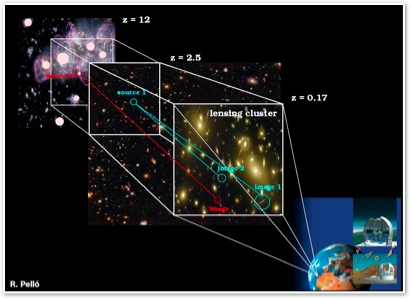primeval galaxies
PI: Roser Pelló
Background
A major challenge of modern cosmology is to characterize the sources responsible for cosmic re-ionization and, in particular, to understand galaxy assembly within the first billion years. This epoch remains unexplored despite the increasing number of observational facilities and devoted surveys. The last results obtained from deep photometry on HST Legacy Fields show clear evidence for a strong evolution in the abundance of star-forming sources between z~3-4 and z~10, based on the UV-rest-frame continuum. However, present estimates of the Luminosity Function still rely on photometrically-selected samples that could be heavily contaminated. Spectroscopy is mandatory to establish a robust sample, and to approach the physics of sources responsible for the reionization. EMIR/GTC will provide unique capabilities in the search and study of galaxies beyond z≥6, where GOYA should have a profound impact on our knowledge of galaxy formation and cosmological reionization.

Procedures
The photometric selection of z≳6 candidates will be done using the “Lyman break” technique (LBG), based on either color-color windows and/or blind photometric redshifts (+ PDZ). Therefore, deep multi-band photometry is mandatory for the needs of this project. Photometric redshifts will be derived by SED-fitting procedures already available including well-suited models to reproduce the properties of extreme high-z sources (e.g. the presence of strong e-lines). As for other GOYA programmes, we rely on public ancillary data. Deep HST photometry in the Optical+NIR is mandatory, and deep Spitzer/IRAC data is highly recommended. Several blank field surveys fulfil these conditions (EGS/WUDS, COSMOS, GOODN-N). We have performed our own selection of high-z candidates in the AEGIS fields (WUDS, ~400 arcmin2 and WIRDS, ~1000 arcmin2). In addition, GOYA should consider pointing at least one lensing cluster with similar (ultra)deep public data, extracted from the Hubble Frontier Fields Survey. Our group has selected promising candidates in MACSJ0416.1-2403 and MACSJ0717.5+3745, and well-suited lensing models are available for these clusters. As for blank fields, several sciences cases could be simultaneously conducted in such fields (cluster galaxies, intrinsically-faint/low-mass lensed galaxies at intermediate-z).
Objetives
The main goals and the results expected from this aspect of GOYA can be summarized as follows: I) The Lyman alpha luminosity and equivalent widths (estimated using the broad-band fluxes) and SED-fitting will provide a measurement of the SFR, and a combined constraint on the maximum age / Initial Mass Function / metallicity of the objects based on models. If metal lines (e.g. CIV 1550...) are detected/measured, these will provide direct constraints on the metallicity through using photoionisation models. ii) The detection of HeII 1640 emission (together with the detection or non-detection of metal lines) would be a unique indication of extremely metal-poor stellar populations or AGN activity, when combined with other lines. iii) Lyman alpha profiles and estimates of the IGM transmission will be used to place constraints on the contribution of these objects to cosmic re-ionization.